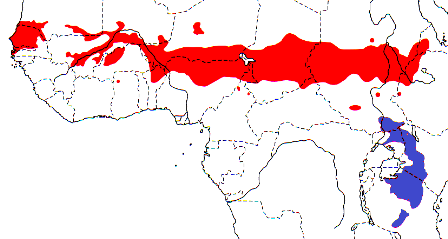Weaver Wednesday [43]: Speckle-fronted Weaver 2013-04-10 (352)
 Weaver Wednesday
Weaver Wednesday

The Speckle-fronted Weaver Sporopipes frontalis is one of the smallest weavers. It is finch-like, with a short stubby bill. The head pattern is distinctive (see right) - the black feathers on the crown are tipped white, giving a speckled effect, which gives rise to its name. The nape is chestnut and there is a black moustachial streak surrounding the broad pale grey face. The sexes are alike. The juvenile is like the adult but paler, especially on the nape, which is tawny rather than chestnut. The Chestnut-crowned Sparrow-Weaver Plocepasser superciliosus is much larger and has a chestnut crown and ear-coverts.

Two subspecies of the Speckle-fronted Weaver are recognised (see map below, based on Birds of Africa):
S. f. frontalis from Mauritania, Senegal and Gambia across the West African savanna belt to Ethiopia and Eritrea (see red on map).
S. f. emini, South Sudan and Uganda south to Tanzania (see blue on map). The mantle of this subspecies is darker grey than in the nominate.
Projected climate change is thought likely to increase its range in the future.
The Speckle-fronted Weaver inhabits dry bush and open thorn-scrub savanna, and thickets, often around villages. It roosts in groups in old nests throughout the year. When not breeding, it is generally gregarious. Birds allopreen, mainly the head. It moves locally during the rains in Mauritania and is apparently present only during the wet season in the sahel zone of Nigeria. Post-breeding wing moult starts in mid-March, and lasts at least 5-6 months in Nigeria. In occurs in pairs during the breeding season and in flocks of 5-10, sometimes 20, at other times. Its food consists of seeds, some small insects (picked up on the ground), and termite alates. It feeds mainly on the ground in open gravelly patches, often alongside waxbills. The Speckle-fronted Weaver moves by hopping.

The Speckle-fronted Weaver is a monogamous, solitary nester, or it may form small colonies. The nest is a large, untidy ball of dry grass with a long entrance tunnel on the side. The nest is lined with finer material and a few grass seed heads, and rarely with feathers. The nest chamber is formed by trampling material. The nest is sited in Ziziphus shrubs, or in branches of acacia trees, 2-6 m above the ground. Nests may be sited near wasp nests. Clutch size is 2-4 eggs, with generally 2 near its northern limits and 3-4 further south. In one record of nest predation, 4 nests in Kenya were raided by a pair of wood-hoopoes which ate several eggs.
The Speckle-fronted Weaver has 2 PHOWN records - see news about the first PHOWN record. Many more PHOWN records are needed for this species (see PHOWN summary). Active or old nests may be taken over for breeding by Red-cheeked Cordon-bleau Uraeginthus bengalus. Submit any weaver nest records to PHOWN (PHOtos of Weaver Nests) via the Virtual Museum upload site.
PHOWN summary
Previous Wedn: Black-chinned Weaver
Full weaver species list
|


 Weaver Watch
Weaver Watch


